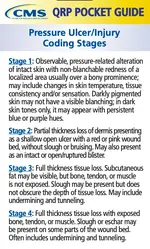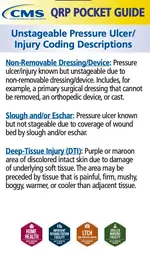Pressure Injury:
A pressure injury is localized damage to the skin and underlying soft tissue usually over a
bony prominence or related to a medical or other device. The injury can present as intact skin
or an open ulcer. The injury occurs as a result of intense and/or prolonged pressure.
Stage 1 Pressure Injury:
Non-blanchable erythema of intact skin
Intact skin with a localized area of non-blanchable erythema. Presence of blanchable erythema or changes in sensation, temperature, or firmness may precede visual changes. Color changes do not include purple or maroon discoloration; these may indicate deep tissue pressure injury.
Stage 2 Pressure Injury:
Partial-thickness skin loss with exposed dermis
Partial-thickness loss of skin with exposed dermis. The wound bed is viable, pink or red, moist, and may also present as an intact or ruptured serum-filled blister. Adipose (fat) is not visible and deeper tissues are not visible. Granulation tissue, slough and eschar are not present. These injuries commonly result from adverse microclimate and shear in the skin over the pelvis and shear in the heel. This stage should not be used to describe moisture associated skin damage (MASD) including incontinence associated dermatitis (IAD), intertriginous dermatitis (ITD), medical adhesive related skin injury (MARSI), or traumatic wounds (skin tears, burns, abrasions).
Stage 3 Pressure Injury:
Full-thickness skin loss
Full-thickness loss of skin, in which adipose (fat) is visible in the ulcer and granulation tissue and
epibole (rolled wound edges) are often present. Slough and/or eschar may be visible. The depth of tissue damage varies by anatomical location; areas of significant adiposity can develop deep
wounds. Undermining and tunneling may occur. Fascia, muscle, tendon, ligament, cartilage and/or bone are not exposed. If slough or eschar obscures the extent of tissue loss this is an Unstageable Pressure Injury.
Stage 4 Pressure Injury:
Full-thickness skin and tissue loss
Full-thickness skin and tissue loss with exposed or directly palpable fascia, muscle, tendon,
ligament, cartilage or bone in the ulcer. Slough and/or eschar may be visible. Epibole (rolled edges), undermining and/or tunneling often occur. Depth varies by anatomical location. If slough or eschar obscures the extent of tissue loss this is an Unstageable Pressure Injury.
Unstageable Pressure Injury:
Obscured full-thickness skin and tissue loss
Full-thickness skin and tissue loss in which the extent of tissue damage within the ulcer cannot be
confirmed because it is obscured by slough or eschar. If slough or eschar is removed, a Stage 3 or
Stage 4 pressure injury will be revealed.
Category L89 contains combination codes to identify the site, laterality and pressure ulcer stages. ICD-10-CM also includes a code category for pressure ulcers that span multiple body parts.
The category of codes for pressure ulcers (L89) has a note to code first any associated gangrene from category I96. Because there are several pages of ICD-10-CM codes for pressure ulcers, make a BHAT® note at the top of each page of your ICD-10-CM manual to remind you to code associated gangrene first, if applicable.
A pressure injury is localized damage to the skin and underlying soft tissue usually over a
bony prominence or related to a medical or other device. The injury can present as intact skin
or an open ulcer. The injury occurs as a result of intense and/or prolonged pressure.
Stage 1 Pressure Injury:
Non-blanchable erythema of intact skin
Intact skin with a localized area of non-blanchable erythema. Presence of blanchable erythema or changes in sensation, temperature, or firmness may precede visual changes. Color changes do not include purple or maroon discoloration; these may indicate deep tissue pressure injury.
Stage 2 Pressure Injury:
Partial-thickness skin loss with exposed dermis
Partial-thickness loss of skin with exposed dermis. The wound bed is viable, pink or red, moist, and may also present as an intact or ruptured serum-filled blister. Adipose (fat) is not visible and deeper tissues are not visible. Granulation tissue, slough and eschar are not present. These injuries commonly result from adverse microclimate and shear in the skin over the pelvis and shear in the heel. This stage should not be used to describe moisture associated skin damage (MASD) including incontinence associated dermatitis (IAD), intertriginous dermatitis (ITD), medical adhesive related skin injury (MARSI), or traumatic wounds (skin tears, burns, abrasions).
Stage 3 Pressure Injury:
Full-thickness skin loss
Full-thickness loss of skin, in which adipose (fat) is visible in the ulcer and granulation tissue and
epibole (rolled wound edges) are often present. Slough and/or eschar may be visible. The depth of tissue damage varies by anatomical location; areas of significant adiposity can develop deep
wounds. Undermining and tunneling may occur. Fascia, muscle, tendon, ligament, cartilage and/or bone are not exposed. If slough or eschar obscures the extent of tissue loss this is an Unstageable Pressure Injury.
Stage 4 Pressure Injury:
Full-thickness skin and tissue loss
Full-thickness skin and tissue loss with exposed or directly palpable fascia, muscle, tendon,
ligament, cartilage or bone in the ulcer. Slough and/or eschar may be visible. Epibole (rolled edges), undermining and/or tunneling often occur. Depth varies by anatomical location. If slough or eschar obscures the extent of tissue loss this is an Unstageable Pressure Injury.
Unstageable Pressure Injury:
Obscured full-thickness skin and tissue loss
Full-thickness skin and tissue loss in which the extent of tissue damage within the ulcer cannot be
confirmed because it is obscured by slough or eschar. If slough or eschar is removed, a Stage 3 or
Stage 4 pressure injury will be revealed.
Category L89 contains combination codes to identify the site, laterality and pressure ulcer stages. ICD-10-CM also includes a code category for pressure ulcers that span multiple body parts.
The category of codes for pressure ulcers (L89) has a note to code first any associated gangrene from category I96. Because there are several pages of ICD-10-CM codes for pressure ulcers, make a BHAT® note at the top of each page of your ICD-10-CM manual to remind you to code associated gangrene first, if applicable.





